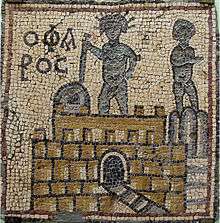Olbia, Libya
.jpg)
Olbia or Theodorias was a Roman / Byzantine town between Marj and Bayda in the Cyrenaica region of modern Libya. Olbia is now mostly the archaeological site. The location's modern name is Qasr Libya, after the Islamic period castle (Qasr) on the site and Libya or Lebia as a corruption of the ancient name Olbia.
History
After destruction by the Vandals and incursions by Laguatan (Lwatae) nomads, it was refounded in 539 CE as Polis Nea Theodorias[1] by the Byzantine empress Theodora.

All that remains of the town are two Byzantine churches. One is integrated into the Qasr, which now houses the Qasr Libya Museum. The other church was excavated by Richard Goodchild in the mid 1950s.[2] Only the floor plan remains, but fifty beautiful mosaic panels depicting the known world and the refoundation and adornment of the city by Theodora are on display in the museum.[3]
Notes
- ↑ Beckwith, John (1993) Early Christian and Byzantine Art Yale University Press, New Haven, Connecticut, p. 74, ISBN 0-300-05296-0
- ↑ Pliez, Olivier (ed.) (2009) "Qasr Libya (Olbia-Theodoria)" Le Petit Futé Libye Petit Futé, Paris, p. 241, ISBN 2-7469-2276-2; in French
- ↑ Azema, James (2000) "East of Barce" Libya Handbook: The Travel Guide p. 163, Footprint Travel Guides, Bath, England, ISBN 1-900949-77-6
References
- Goodchild, Richard. The Great, newly discovered mosaic floor of Qasr el-Lebia. London Illustrated Evening News , Dec. 14th 1957
- Williams, Gwyn. Green Mountain - an informal guide to Cyrenaica and its Jebel Akhdar. Faber and Faber 1963
External links
Coordinates: 32°38′N 21°24′E / 32.633°N 21.400°E